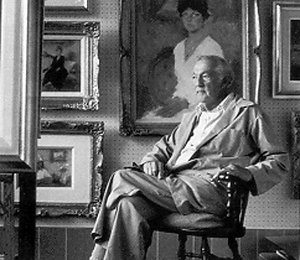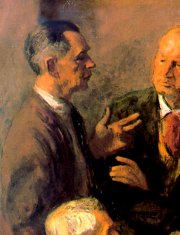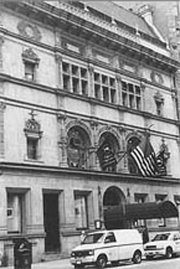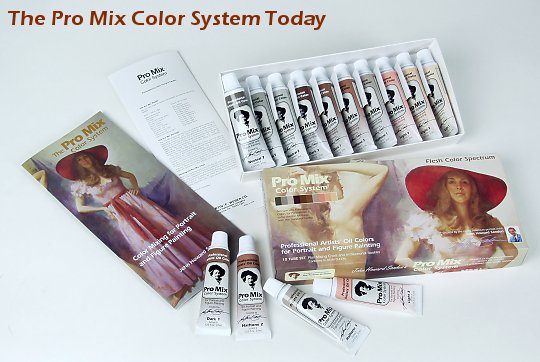A Study of Velázquez' Technique Results
In Portrait Pigments for Today
Those perfect flesh tones in the portraits of
Velázquez—available for today's
artists.
(The first of three articles on this subject.)
 n
1624, in Madrid, Spain, Diego de Velázquez
stood before his easel. Opposite the great artist
stood Philip IV, King of Spain. As the light
from the window fell on the young monarch's
face, the artist dipped his brush into the white
pigment, then into yellow ochre, and finally
into mercury vermilion, the warm red then in
use. The artist's brush swirled the three pigments
together, producing just exactly the shade on
the king's forehead. n
1624, in Madrid, Spain, Diego de Velázquez
stood before his easel. Opposite the great artist
stood Philip IV, King of Spain. As the light
from the window fell on the young monarch's
face, the artist dipped his brush into the white
pigment, then into yellow ochre, and finally
into mercury vermilion, the warm red then in
use. The artist's brush swirled the three pigments
together, producing just exactly the shade on
the king's forehead.

Samuel Edmund Oppenheim
(1901-1992) |
Three hundred years later, in New York, a young
Russian emigré, beginning his art studies,
stood before another Velázquez painting
in the Metropolitan Museum of Art. That swirl
of three pigments still lay glistening on the
painted face. Experiments on the student artist's
palette (substituting cadmium red light for
vermilion of mercury) confirmed the mixture.
The young art student was Samuel Edmund Oppenheim
(1901-1992) who became a leading American painter
and teacher. His popular classes in oil portraiture
at the Art Students League of New York (1966-1972)
were innovative and influential. Oppenheim continued
his studies of Velázquez throughout a
long painting career.
Oppenheim's years of intimate and painstaking
scrutiny and analysis of Velázquez paintings
resulted in a series of pigment formulations,
which Oppenheim considered fundamental to the
structure of a Velázquez portrait (for
a detailed description of the pigment combinations,
click on "Descriptions of the Oppenheim/Velázquez
Pigment Combinations" below.) These pigment
formulations were passed on to Oppenheim's students
at the League.
These formulations included three pigment combinations
for light-struck areas (in the normal Caucasian
complexion), two combinations for transitional,
or "halftone" areas, and two darks
for shadow areas. These seven pigments had to
be further modified by the inclusion of additional
colors to precisely match the observed phenomena.
In other words, the Oppenheim/Velázquez
pigment combinations were not "formula"
colors, but simply starting points for the final
color mixture, to be arrived at through traditional
observation-based analysis and adjustment.
In 1974, the Manufacture
of the Velázquez/Oppenheim
Pigment Combinations Is Sponsored by the Art
Students League of New York.

Stewart Klonis, Executive Director,
The Art Students League of New York, who
made possible the manufacture of the Velazquez/
Oppenheim pigment combinations, which became
known as the Pro Mix Color System.
Detail
of the painting Homage to Sargent by Robert
Phillip. Collection, the Art Students
League of New York.
|
|
In 1972, Samuel Oppenheim retired from teaching
at the Art Students League of New York, and
I was hired to teach his class. Eager to perpetuate
his teaching concepts, I formulated the pigment
combinations that he had given us, and asked
the Martin/F. Weber Company of Philadelphia
to produce them. The Weber Company, the oldest
American manufacturer of artists' colors, had
been founded by Frederick Weber, longtime lecturer
on artists' techniques at the Art Students League.
This fact inspired me to approach Stewart Klonis,
Executive Director of the League, with the proposal
that the League serve as financial sponsor for
the colors, which by now had been christened
the "Pro Mix Color System." Mr. Klonis
took the proposal to the League's Board of Control,
which voted unanimously to fund the undertaking.
Thus the Velázquez/Oppenheim pigment
combinations, rechristened the "Pro Mix
Color System" were born, in 1974, with
the League's blessing and financial backing.

The Art Students League,
which, in 1974, provided
financial backing for the
Pro Mix Color System.
In the 32 years since,
50,000 artists worldwide
have used the colors. |
In the 32 years since, the colors have been
purchased by 50,000 artists around the world.
Many of the world's leading professional portrait
artists are devoted to their use.
Over the past three decades, these portrait
pigments have been the object of occasional
criticism by artists not familiar with their
use, the principal charges being that they are
"formula colors" or "shortcuts."
These charges are unwarranted, and I would like
to answer them definitively in the next article
in this space.

John Howard Sanden

The Oppenheim/Velazquez
Pigment Combinations are available as The Pro
Mix Color System from The Portrait Institute at
www.portraitinstitute.com.
Additional relevant material:
Descriptions of the
Oppenheim/Velázquez Pigment Combinations
(Today's Pro Mix Color System).
Returning to the Oppenheim/Velázquez
pigment combinations, it is important to repeat
that these were based on a close scrutiny of
the visible paint film on Velázquez paintings,
both in this country and in Europe. Oppenheim
concluded that there was a basic pigment combination
that recurred constantly throughout the Spanish
master's oeuvre. That combination is best rendered
today by combining white, yellow ochre and cadmium
red light.
Of course, cadmium colors did not enter the
standard list until the nineteenth century.
Velázquez used vermilion of mercury,
a warm intense red, now obsolete. Five of the
Oppenheim/Velázquez combinations are
based on this three-pigment combination: white,
yellow ochre and cadmium red light. Oppenheim
gave us these three pigments in three slightly
different variations, introducing a touch of
cerulean blue into two of them, and numbering
the combinations Light 1, 2 and 3. Light 2 is
slightly darker and more intense than Light
1; Light 3 is darker and more intense still.
Oppenheim returned again to this three-way combination
to produce two transitional, or halftone colors.
Starting again with white, yellow ochre and
cadmium red light, he added a touch of viridian—enough
to produce a soft, delicate greenish halftone
color, especially valuable when painting receding
planes on the Caucasian face. He called this
Halftone 1.
A second halftone color was achieved by reducing
the amount of viridian and introducing a touch
of cadmium orange, producing a warm, rich halftone
color especially useful where light and shadow
areas meet.
For the shadow areas, Oppenheim gave us a powerful,
very proactive pigment combination he had extrapolated
from his study of Velázquez: combining
burnt sienna and viridian produces a rich dark
brown, adding cadmium orange enriches the mixture
still further. This volatile mixture can easily
be moved from warm to cool and vise versa. A
touch of white mixed into this dulls the intensity
slightly and raises the value. Hence the two
"Pro Mix" darks, Dark I and 2.
To quickly reduce the intensity of all colors,
the use of neutral greys—in various values—are
placed on the palette for convenience. Mixing
ivory black with white, and adding a touch of
yellow ochre for warmth, three neutral tones
are created: Neutral 3 (33-1/3%), Neutral 5
(50%) and Neutral 7 (66-2/3%). These grays are
positioned on a value scale of nine tones, with
white being zero, and black, value 9.
Putting the Oppenheim/Velázquez
Pigment Combinations (Today's ProMix Colors)
Into Practice.
The Pro Mix Color System palette consists of
two rows of colors. The top row consists of
twelve standard colors (from left): Ultramarine
Blue, Cerulean Blue, Viridian, Chromium Oxide
Green, Alizarin Crimson, Burnt Umber, Burnt
Sienna, Cadmium Orange, Venetian Red, Cadmium
Red Light, Yellow Ochre and Cadmium Yellow Light.
The lower row consists of (from left): Ivory
Black, Pro Mix Neutral 7, Neutral 5, Neutral
3, Dark 2, Dark I, Halftone 2, Halftone 1, Light
3, Light 2, Light 1 and White. The Pro Mix colors
are adjusted for hue, value and intensity by
mixing with other Pro Mix colors, or with colors
from the upper row of standard colors.
The ten Pro Mix colors are thus not "crutches"
or a "paint-by-number" shortcut. The
ten Pro Mix colors are, in fact, simple traditional
flesh color combinations used by all portrait
artists since the introduction of oil painting.
The artist modifies and adjusts each of the
Pro Mix colors—based on observation of
the subject—in exactly the same way he
would a color from the standard palette. 78
such modifications are demonstrated in the Pro
Mix mixing chart, included with each boxed set
of the colors.
The Traditional Protocol
for All Color Mixtures.
The traditional protocol for all color mixtures
is a four-step procedure. First, the
artist observes the natural phenomena. Second,
looking down to the palette, the artist selects
the single pigment that appears closest to the
desired destination. Third, the artist
must analyze the difference between what is
observed and the color on the knife or brush.
Does the selected pigment need to be adjusted
in hue (made warmer or cooler)? Does it need
to be adjusted in value (made lighter or darker),
or does it need to be adjusted in intensity
or, perhaps, all three of these? The fourth
and final step is to make the necessary
adjustments, by introducing into the mixture
additional, and necessary, components.
|